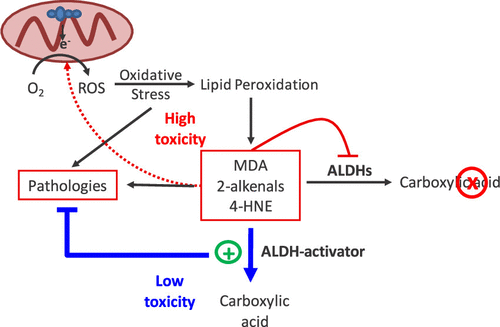当前位置:
X-MOL 学术
›
Chem. Res. Toxicol.
›
论文详情
Our official English website, www.x-mol.net, welcomes your
feedback! (Note: you will need to create a separate account there.)
Role of Aldehyde Dehydrogenases in Physiopathological Processes.
Chemical Research in Toxicology ( IF 3.7 ) Pub Date : 2019-01-25 , DOI: 10.1021/acs.chemrestox.8b00256 José Salud Rodríguez-Zavala 1 , Luis Francisco Calleja 1 , Rafael Moreno-Sánchez 1 , Belem Yoval-Sánchez 1
Chemical Research in Toxicology ( IF 3.7 ) Pub Date : 2019-01-25 , DOI: 10.1021/acs.chemrestox.8b00256 José Salud Rodríguez-Zavala 1 , Luis Francisco Calleja 1 , Rafael Moreno-Sánchez 1 , Belem Yoval-Sánchez 1
Affiliation

|
Many different diseases are associated with oxidative stress. One of the main consequences of oxidative stress at the cellular level is lipid peroxidation, from which toxic aldehydes may be generated. Below their toxicity thresholds, some aldehydes are involved in signaling processes, while others are intermediaries in the metabolism of lipids, amino acids, neurotransmitters, and carbohydrates. Some aldehydes ubiquitously distributed in the environment, such as acrolein or formaldehyde, are extremely toxic to the cell. On the other hand, aldehyde dehydrogenases (ALDHs) are able to detoxify a wide variety of aldehydes to their corresponding carboxylic acids, thus helping to protect from oxidative stress. ALDHs are located in different subcellular compartments such as cytosol, mitochondria, nucleus, and endoplasmic reticulum. The aim of this review is to analyze, and highlight, the role of different ALDH isoforms in the detoxification of aldehydes generated in processes that involve high levels of oxidative stress. The ALDH physiological relevance becomes evident by the observation that their expression and activity are enhanced in different pathologies that involve oxidative stress such as neurodegenerative disorders, cardiopathies, atherosclerosis, and cancer as well as inflammatory processes. Furthermore, ALDH mutations bring about several disorders in the cell. Thus, understanding the mechanisms by which these enzymes participate in diverse cellular processes may lead to better contend with the damage caused by toxic aldehydes in different pathologies by designing modulators and/or protocols to modify their activity or expression.
中文翻译:

醛脱氢酶在生理病理过程中的作用。
许多不同的疾病都与氧化应激有关。在细胞水平上氧化应激的主要后果之一是脂质过氧化,从中可产生有毒的醛。低于其毒性阈值时,某些醛会参与信号传导过程,而另一些醛会参与脂质,氨基酸,神经递质和碳水化合物的代谢。在环境中普遍分布的某些醛,例如丙烯醛或甲醛,对细胞具有极高的毒性。另一方面,醛脱氢酶(ALDHs)能够将多种醛解毒为其相应的羧酸,从而有助于防止氧化应激。ALDH位于不同的亚细胞区室,例如细胞质,线粒体,细胞核和内质网。这篇综述的目的是分析和强调不同的ALDH同工型在涉及高水平氧化应激的过程中产生的醛的解毒中的作用。通过观察到它们的表达和活性在涉及氧化应激的不同病理(例如神经退行性疾病,心脏病变,动脉粥样硬化和癌症以及炎性过程)中的增强而变得明显,ALDH的生理相关性变得明显。此外,ALDH突变引起细胞中的几种疾病。因此,通过设计调节剂和/或方案以修饰其活性或表达,了解这些酶参与不同细胞过程的机制可以更好地应对由不同病理形式的有毒醛引起的损害。在涉及高水平氧化应激的过程中产生的醛的解毒过程中,不同的ALDH同工型的作用。通过观察到它们的表达和活性在涉及氧化应激的不同病理(例如神经退行性疾病,心脏病变,动脉粥样硬化和癌症以及炎性过程)中的增强而变得明显,ALDH的生理相关性变得明显。此外,ALDH突变引起细胞中的几种疾病。因此,通过设计调节剂和/或方案以修饰其活性或表达,了解这些酶参与不同细胞过程的机制可以更好地应对由不同病理形式的有毒醛引起的损害。在涉及高水平氧化应激的过程中产生的醛的解毒过程中,不同的ALDH同工型的作用。通过观察到它们的表达和活性在涉及氧化应激的不同病理(例如神经退行性疾病,心脏病变,动脉粥样硬化和癌症以及炎性过程)中的增强而变得明显,ALDH的生理相关性变得明显。此外,ALDH突变引起细胞中的几种疾病。因此,通过设计调节剂和/或方案以修饰其活性或表达,了解这些酶参与不同细胞过程的机制可以更好地应对由不同病理形式的有毒醛引起的损害。
更新日期:2019-01-10
中文翻译:

醛脱氢酶在生理病理过程中的作用。
许多不同的疾病都与氧化应激有关。在细胞水平上氧化应激的主要后果之一是脂质过氧化,从中可产生有毒的醛。低于其毒性阈值时,某些醛会参与信号传导过程,而另一些醛会参与脂质,氨基酸,神经递质和碳水化合物的代谢。在环境中普遍分布的某些醛,例如丙烯醛或甲醛,对细胞具有极高的毒性。另一方面,醛脱氢酶(ALDHs)能够将多种醛解毒为其相应的羧酸,从而有助于防止氧化应激。ALDH位于不同的亚细胞区室,例如细胞质,线粒体,细胞核和内质网。这篇综述的目的是分析和强调不同的ALDH同工型在涉及高水平氧化应激的过程中产生的醛的解毒中的作用。通过观察到它们的表达和活性在涉及氧化应激的不同病理(例如神经退行性疾病,心脏病变,动脉粥样硬化和癌症以及炎性过程)中的增强而变得明显,ALDH的生理相关性变得明显。此外,ALDH突变引起细胞中的几种疾病。因此,通过设计调节剂和/或方案以修饰其活性或表达,了解这些酶参与不同细胞过程的机制可以更好地应对由不同病理形式的有毒醛引起的损害。在涉及高水平氧化应激的过程中产生的醛的解毒过程中,不同的ALDH同工型的作用。通过观察到它们的表达和活性在涉及氧化应激的不同病理(例如神经退行性疾病,心脏病变,动脉粥样硬化和癌症以及炎性过程)中的增强而变得明显,ALDH的生理相关性变得明显。此外,ALDH突变引起细胞中的几种疾病。因此,通过设计调节剂和/或方案以修饰其活性或表达,了解这些酶参与不同细胞过程的机制可以更好地应对由不同病理形式的有毒醛引起的损害。在涉及高水平氧化应激的过程中产生的醛的解毒过程中,不同的ALDH同工型的作用。通过观察到它们的表达和活性在涉及氧化应激的不同病理(例如神经退行性疾病,心脏病变,动脉粥样硬化和癌症以及炎性过程)中的增强而变得明显,ALDH的生理相关性变得明显。此外,ALDH突变引起细胞中的几种疾病。因此,通过设计调节剂和/或方案以修饰其活性或表达,了解这些酶参与不同细胞过程的机制可以更好地应对由不同病理形式的有毒醛引起的损害。


















































 京公网安备 11010802027423号
京公网安备 11010802027423号